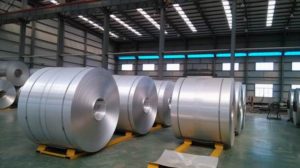Aluminum alloys are divided into two major categories: wrought and casting alloys. A further differentiation for each category is based primary on mechanism of property development. Many Aluminum alloys respond to thermal treatment based on phase solubility. These treatments include solution heat treatment, quenching and precipitation, or age hardening.

In order to improve surface properties of final products, such as wear resistance, corrosion resistance, reflectivity etc., different types of surface treatment were designed. All of them are divided into several groups, such as electrochemical treatments, chemical treatments and coatings. In this article their terms and definitions will be explained.
Electrochemical treatment
Electrochemical brightening: Electrochemical treatment to improve the optical reflectivity of a surface.
Electropolishing: Polishing of a metal surface by making it anodic in an appropriate electrolyte.
Anodized metal Metal with an anodic coating, produced by an electrolytic oxidation process in which the metal is converted to a mainly oxide coating having protective, decorative or functional properties.
Clear anodized metal: Metal with a substantially colorless, translucent anodic oxidation coating.
Color anodized metal: Anodized metal colored either during anodizing or by subsequent coloring processes.
Integral color anodized metal: Metal that has been anodized using an appropriate (usually organic acid based) electrolyte which produces a colored coating during the anodizing process itself.
Electrolytically colored anodized metal: Metal with an anodic oxidation coating that has been colored by the electrolytic deposition of a metal or metal oxide into the pore structure.
Dyed anodized metal: Metal with an anodic oxidation coating colored by absorption of dye-stuff or pigments into the pore structure.
Combination color anodized metal: Metal with an anodic oxidation coating that is colored by electrolytic coloring or produced by integral color anodizing followed by absorption dyeing.
Interference color anodized metal: Metal with an anodic oxidation coating colored by means of optical interference effects.
Bright anodized metal: Anodized metal with a high specular reflectance as the primary characteristic.
Protective anodizing: Anodizing where protection against corrosion or wear is the primary characteristic and appearance is secondary or of no importance.
Decorative anodizing: Anodizing where a decorative finish with a uniform or a esthetically pleasing appearance is the primary characteristic.
Architectural anodizing: Anodizing to produce an architectural finish to be used in permanent, exterior and static situations where both appearance and long life are important.
Hard anodized metal: Anodized metal on which the anodic oxidation coating has been produced with wear and/or abrasion resistance as the primary characteristic.
Sealing: Treatment of anodic oxidation coatings on metal to reduce porosity and the absorption capacity of the coating by hydrothermal processes carried out after anodizing.
Cold impregnation: Treatment of anodic oxidation coatings on metal to plug the pores and reduce the absorption capacity of the coating by chemical processes carried out at low temperatures after anodizing.
Significant surface: The part of the product covered or to be covered by the coating and for which the coating is essential for serviceability and/or appearance.
Chemical treatment
Chemical brightening: Chemical treatment to improve the optical reflectivity of a surface.
Chemical polishing: Polishing of a metal surface by immersion in a solution of chemical reagents.
Degreasing: Removal of oil or grease, usually by a suitable organic solvent or an aqueous detergent.
Etching: Roughening of the surface of a metal by overall or selective dissolution in acid or caustic media.
Pickling: Removal of a thin surface layer of a metal by chemical action, mainly by treatment in a caustic solution.
Coating
Coating (organic): Method in which a coating material is applied on a metallic substrate. This process includes cleaning and chemical pre-treatment and either:
one-side or two-side, single or multiple application of liquid or powder coating materials which are subsequently cured or
laminating with plastic films.
Coil coating: Continuous coating of a metal strip.
Backing coat: Single coating of any type with no particular requirements for appearance, malleability, corrosion protection, etc. usually on the reverse side of the coated product.
Chemical conversion coating: Treatment of a metal with chemical solutions by dipping or spraying to build up an oxide film containing chromates or phosphates.
Priming: Application of a priming paint often pigmented with a corrosion inhibitor such as zinc chromate, after suitable pretreatment.
Pretreatment priming: Application of a solution containing a resin, a chromate and an acid, which is allowed to dry on and provide the key for subsequent painting.
Single coat system: Single coating either with requirements on appearance, malleability, corrosion protection, subsequent painting, etc., or as a primer with special properties regarding adhesion and corrosion protection for post-painting applications.
Multiple coat system: System comprising a primer or a base coat, possibly intermediate coat(s), and a top coat with particular requirements on appearance, malleability, corrosion protection, etc.
Organic coating: Dry paint film of the coated product or the organic film metal laminate.
Film coating: Organic film applied to a substrate to which an adhesive and, if appropriate, a primer has been applied beforehand.
Lacquering: Coating with a formulation based on a dissolved material which forms a transparent layer primarily after drying by evaporation of the solvent.
